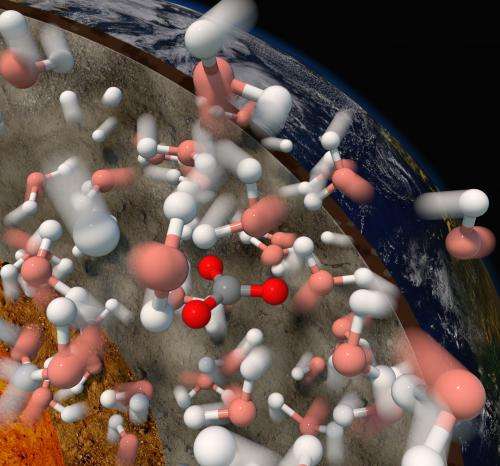Computer models show how deep carbon could return to Earth's surface

Computer simulations of water under extreme pressure are helping geochemists understand how carbon might be recycled from hundreds of miles below the Earth's surface. The work, by researchers at the University of California, Davis, and Johns Hopkins University, is published March 18 in the journal Proceedings of the National Academy of Sciences.
Carbon compounds are the basis of life, provide most of our fuels and contribute to climate change. The cycling of carbon through the oceans, atmosphere and shallow crust of the Earth has been intensively studied, but little is known about what happens to carbon deep in the Earth.
"We are trying to understand more about whether carbon can be transported in the deep Earth through water-rich fluids," said coauthor Dimitri Sverjensky, professor of earth and planetary sciences at Johns Hopkins University.
There is plenty of water in the mantle, the layer of the planet extending hundreds of miles below the Earth's crust, but little is known about how water behaves under the extreme conditions there—pressures run to hundreds of tons per square inch and temperatures are over 2,500 F.
Experiments reproducing these conditions are very hard to do, said Giulia Galli, professor of chemistry and physics at UC Davis and co-author on the paper. Geochemists have models to understand the deep Earth, but they have lacked a crucial parameter for water under these conditions: the dielectric constant, which determines how easily minerals will dissolve in water.
"When people use models to understand the Earth, they need to put in the dielectric constant of water—but there are no data at these depths," Galli said.
Galli and Sverjensky are collaborators in the Deep Carbon Observatory, supported by the Alfred P. Sloan Foundation, which seeks to understand the role of carbon in chemistry and biology deep in the Earth.
Researchers have speculated that carbon, trapped as carbonate in the shells of tiny marine creatures, sinks to the ocean floor and gets carried into the mantle on sinking crustal plates then is recycled and escapes through volcanoes, Sverjensky said. But there has been no mechanism to explain how this might happen.
Ding Pan, a postdoctoral researcher at UC Davis, used computer simulations of water to predict how it behaves under extreme pressure and temperature. The simulations show that the dielectric constant changes significantly. By bringing that new factor into the existing models of water in the mantle, the researchers predict that magnesium carbonate, which is insoluble at the Earth's surface, would at least partially dissolve in water at that depth.
"It has been thought that this remains solid, but we show that at least part of it can dissolve and could return to the surface, possibly through volcanoes," Sverjensky said. "Over geologic timescales, a lot of material can move this way."
Sverjensky said the new modeling work was a "first step" to understanding how carbon deep in the Earth can return to the surface.
Journal information: Proceedings of the National Academy of Sciences
Provided by UC Davis




















